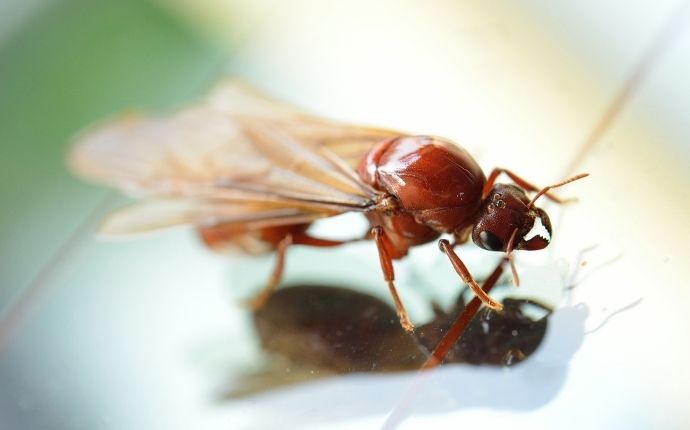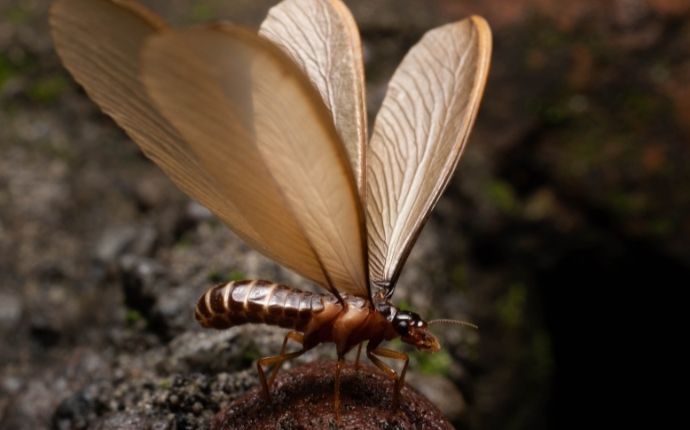Termites are wood-eating pests and are a nuisance for home or business owners. Some termites fly and are commonly mistaken for flying ants. This earned them the nickname “white ants”.
Seeing flying termites could mean that there is a colony nearby, which may have been established for quite some time.
Termites are destructive pests that slowly destroy the structure of homes causing heavy damage over time. In fact, the average colony can consume up to a cubic foot of wood each year.
If you see a flying termite, it is imperative that you exterminate them as soon as possible. This article will help you to identify signs of a termite infestation and how to get rid of them.
What Is a Flying Termite?
Flying termites are also known as “swarmers” or “alates.” These winged termites are responsible for finding and building nests to reproduce and establish new colonies. As the name suggests, these termites swarm areas they want to nest in.
For termites, spring is “swarming season,” and they may swarm multiple times in a season. Very wet or warm winters may impact this, so you may notice swarmers earlier in the year.
Swarmer termites are active during daylight hours and invade in very large numbers. They bury directly underneath homes and use the cracks in the foundation of those homes to burrow, or they might nest in trees.
Once alates find their place to nest, they eventually lose their wings and look like a normal termite, as they no longer need to fly.
Flying ants also mate in the spring, so be sure to take a closer look when you spot a small flying insect. If you are unsure, it is best to call a professional to take a look.
Flying Termite Identification
Flying termites are varying shades of brown, depending on their species. They have two sets of wings, equal in length. This identifier helps differentiate them from flying ants, as those pests have unequal wings.
Flying termites have straight antennae with dark brown rings. They have broad waists with brown rings on the back of their abdomen, becoming lighter as it wraps around the body.
Spotting a flying termite helps to avoid a larger problem. If you are unsure, call a termite control professional!
How To Check for Flying Termites
In addition to knowing how to identify a swarmer termite, it is important to know where they like to hide. The easiest and most obvious way to spot a termite infestation is seeing discarded termite wings. There are other signs that aren’t as obvious so be sure to check for:
- Any wooden flooring for blisters
- Hollowed or damaged wood
- The presence of mud tubes
- Termite droppings or “frass”
Checking for blisters and damaged wood is simple enough, but you may not know what mud tubes or termite droppings may look like. Mud tubes tend to look like a streak of dirt or mud running up a wall and usually come from the ground, though sometimes can originate at roofs or directly out of walls.
The termite droppings, or “frass,” are dark shades of brown or a light beige color. Keep all this information in mind as it will make getting rid of the termites a lot easier in the long run.
Flying Termites vs Flying Ants

Confusing flying termites with flying ants can cause you to use the wrong extermination techniques and the infestation may become worse. Here are some things that are different between the two insects:
- Flying ants have bent antennae while flying termites have straight ones
- Flying ants have a pinched waist, while termites have a straight body structure
- The wings of flying termites are identical in length, while the wings of flying ants are of different lengths
- Flying ants tend to be of a darker color than flying termites
It can be easy to mistake these two insects for each other. While flying ants are a nuisance, they are not as dangerous to your home as flying termites. Knowing the difference will help you to protect your home.
Swarmer Termites: All You Need to Know
Let’s breakdown the most important facts about winged termites.
Why Do Termites Swarm?
Once termite colonies reach a certain capacity level and growth is necessary, swarmer termites emerge. In most cases, this happens once a year. Swarmer termites are reproductive termites, so when they take flight, they mate and seek out a new place to colonize.
Winged termites seek areas with an abundance of wood such as trees, houses, and mounds of mulch. After they successfully colonize a location, the swarmers will lose their wings.
A swarm of termites can land 50,000 at one time. But usually, only 10 percent of the swarmers will successfully pair off and start a new colony.
When Do Termites Swarm?
In most cases, termite swarms occur when the weather starts getting warmer. However, different termite species swarm at different times. Subterranean termites usually swarm in the spring, while dampwood termites swarm in the summertime. It is common to see termite swarms after a day of rain, when conditions are damp and humid. The damp ground is softer, which makes burrowing for colonization easier. Additionally, humid conditions help to boost the survival rates.
How to Get Rid of Flying Termites
There are many ways to get rid of flying termites and control their populations but there is only one way to be 100% sure the termites are gone – and that’s to partner with a professional termite control company.
Bug zappers
These are good for getting rid of flying termites because these termites will accidentally fly into it, as they are often inaccurate with their movement. You can purchase a bug zapper at most home improvement stores. Put them up near where you have seen the swarm of termites.
Orange Oil Spray
Orange oil spray is especially deadly to termites because it contains a compound that is very toxic to them all the while being harmless to humans. The compound is what gives the sprays their citrus scent. Put orange oil into a spray bottle and spray termites you see as well as near any areas where there are signs of infestation.
Cardboard Traps
Create a cardboard trap out of those old Amazon boxes you have laying around! Cardboard contains cellulose, the material termites love to eat. Cut the box into sheets and wet them, and place it near the infested area. The termites will gravitate to the cardboard and begin to eat it. Then, spray the cardboard with an insecticide or bug killer and dispose of the cardboard once the termites die.
Boric Acid
Boric acid is a non-toxic powder that can be effective against termites. Boric acid coats the termite body and dehydrates it, killing the termite. Boric acid can be used indoors or outdoors, so you can sprinkle it in windows, around the perimeter of your home, entryways, and anywhere you see flying termites. To be safe, be sure to keep it away from children and pets. If you apply it outside, reapply every few days, especially after wet weather.
Manage your Landscape
Things like managing the moisture in your soil, creating a termite barrier of pesticides, and being mindful of mulch around your house can greatly help you in getting rid of winged termites. Prevention is as important, if not more important, as getting rid of them.
How to Prevent Flying Termites
Preventing flying termites is a surefire way to lessen the risk of them getting into your house and colonizing. Here are some tips to aid you in prevention:
- Eliminate all potential access points such as small holes in your walls outside or open windows.
- Try trenching around your home/business. Dig a 4 to 6 foot trench around your home’s foundation and sprinkle a termiticide in it.
- Check for increased moisture around your home. Excess moisture can be reduced by fixing water leaks, ensuring enough ventilation, and installing dehumidifiers.
- Clear out extra wood from your yard such as tree stumps, fallen trees, leaf debris, and mulch.
- Keep firewood stored far away from your home
- Protect your foundation by removing any mulch and storing the mulch as far as possible from your home. Also, make sure that at least four inches of the foundation are visible above the soil.
- Keep an eye on and maintain properly functioning drainage systems, so they always direct rainwater away from your home.
Flying Termites FAQs
Are flying termites attracted to light?
Yes, termites are attracted to any light sources you have, so be mindful of areas with an abundance of light.
Are flying termites bad?
Yes, flying termites indicate a potential termite colonization. Termite damage can be severe and threaten the structural integrity in your house, which is often very costly and dangerous.
How long can a flying termite infestation last?
A flying termite infestation will only last a few weeks, but it can indicate an infestation that has existed for a year or more, or will begin a new colonization and this can last until they are removed.
Can I get rid of termites by myself?
While there are DIY methods, it is recommended you call a professional to exterminate the problem as soon as possible when you spot swarmer termites.
What is the average cost of termite treatment?
It can vary greatly based on the severity of the infestation, but the average cost can be between $100 to $200 for initial treatment and up to 50$ for continuous treatment.
If you have any additional questions about flying termites or the swarming season, contact us at (410) 312-7233.
In Conclusion
A termite infestation is not something you can ignore. Termites cause extensive, costly and dangerous damage to the structure of your home. If left alone for too long, termite damage can even be irreparable.
If you see flying termites, you need to take action right away. We have guaranteed pest control solutions and customizable pest control plans to perfectly suit the needs for your home or business. Contact us to schedule your pest control inspection today.





